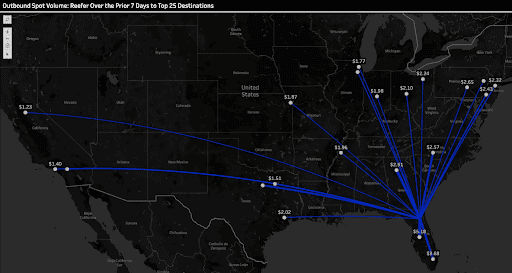Every year when March 17 rolls around, just over half of American adults gear up to wear something green and make plans to celebrate with family and friends. While St. Patrick’s Day is a serious cause for celebration and even a cultural holiday in Savannah, GA, and parts of Massachusetts, it is nonetheless a recognition of our deep connections to Irish and Irish American culture. It’s also one of those not insignificant retail events that create more demand for truckload carriers.
In their annual survey of consumers, the National Retail Federation (NRF) estimated that consumers are expected to spend an average of $42.33 on St. Patrick’s Day in 2022 for a total of $5.87 billion in retail sales, which is 14% higher than last year. 54% of consumers plan to celebrate this year compared to 49% in 2021. Color matters on St Patrick’s Day, and this year 80% of consumers plan to wear something green, 34% will be making a special dinner at home, with around 19% planning to attend a party at a bar or restaurant. That’s almost double the number planning to eat out this year compared to last year and a welcome boost to the foodservice economy and refrigerated truckload carriers.
Get the clearest, most accurate view of the truckload marketplace with data from DAT iQ.
Tune into DAT iQ Live, live on YouTube or LinkedIn, 10am ET every Tuesday.
Some of the freight truckers will be hauling this week for St. Patrick’s Day will include green beer, green cheese, potatoes, flour, eggs, and beef for Shepherd’s Pie, and of course, no St. Patrick’s Day in America would be complete without a dinner of corned beef and cabbage. That dish is not quite as Irish as you think it is and comes from the early days of Irish immigrants in America, not the old country itself.
What should reefer carriers expect this week?
A lot of green retail freight will have been positioned in retail stores well in advance of this weekend’s celebrations. For commodities like eggs, beef brisket and cabbage, this week will typically see higher volumes for refrigerated carriers at a time when capacity has been loosening and spot rates dropping. That won’t be the case in Florida though, where just under half of all cabbage is grown in March.
Cabbage is considered a cool-weather crop, with most production occurring in the fall, winter and spring months in the southern states and extending into the summer in the northern states. According to the USDA, although cabbage is grown throughout the US, 82% of the nation’s total cabbage (fresh market and processing) is produced in five states: California, Wisconsin, New York, Florida and Texas. Most of the reefer volume of cabbage will be coming out of northern Florida (est. 245 truckloads/week) in the Jacksonville freight market. Still, carriers can expect equal volumes from Mexico, the Rio Grande Valley in Texas, and Yuma, AZ, at a rate of around 100 truckloads per week.
Will shippers be paying more to move cabbage this year?
If we focus on where the majority of the cabbage action is this week, the Jacksonville market offers carriers a selection of reefer rates ranging from $6.16/mile excl. FSC to nearby Orlando, $2.77/mile to Boston and $1.43/mile to Los Angeles. Loads north to Chicago where the rivers turn green this week averaged $2.15/mile excl. FSC and are forecast to increase to $2.18/mile by St Patrick’s Day and as high as $3.13/mile excl. FSC on Independence Day. winter blues give way to all things green this week.

Jacksonville average outbound reefer spot rate to top 25 destinations


